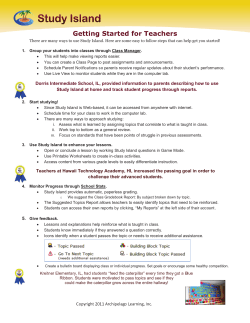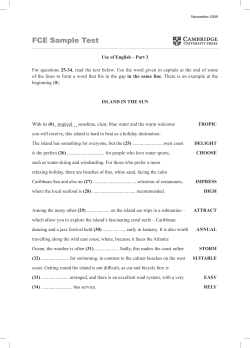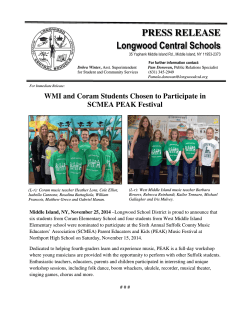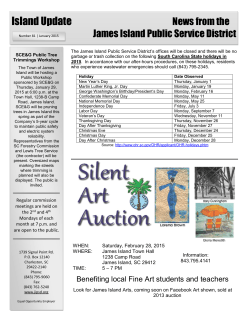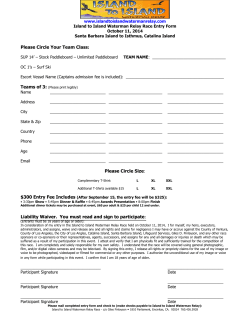
Title/Name of the area - Convention on Biological Diversity
Title/Name of the area: Strait of Hormuz Presented by Koosha Dab Centre for Sustainable Development (CENESTA) www.cenesta.org Mobile: +98-9125599884 Email: koosha@cenesta.org Skype: kooshadab Abstract The Strait of Hormuz connects the Persian Gulf to the Gulf of Oman, part of the Arabian Sea in the northwest Indian Ocean. The area comprises six islands of Qeshm, Hormuz, Larak, Hengam, Greater Tunb and the Lesser Tunb as well as more than 250 km of mainland coastal areas of Iran. The area includes several protected areas, international wetlands, biosphere reserves and important bird areas (IBAs). The Strait of Hormuz has a wide range of terrestrial and marine habitats including coral reefs, mangrove forests, seagrass beds, estuaries, and rocky, muddy and sandy shores. The coral reefs of the area are among the richest and healthiest ecosystems in the Persian Gulf. This area supports significant feeding, breeding and nursery grounds for sea turtles, waterbirds, dolphins, reef fishes, sharks, ray and skates. Introduction The Strait of Hormuz is a channel approximately 50 km wide and 100 m deep at its narrowest point and connects the Persian Gulf, a warm, hypersaline, shallow and semi-enclosed sea to the Gulf of Oman, a relatively more exposed to deep component of the Arabian Sea in the northwest Indian Ocean. The Strait of Hormuz is greatly influenced by the less saline and nutrient-rich oceanic waters from Indian Ocean, while the inner parts of the Persian Gulf tolerate a more saline and less fertile condition prevailed in nearly entire region. Water enters the semi-enclosed Persian Gulf through the Strait of Hormuz and a density and wind driven counter-clockwise current flows northwest along the Iranian coast and then southeast along the Arabian coast with a flushing time that ranges from 3 to 5.5 years. Due to counter-clockwise pattern of the water circulation in the Persian Gulf, the northern part and the Iranian coastline has better environmental conditions including lower temperature, lower salinity, better aragonite saturation and greater depth. This results in increasing species richness towards the Straits of Hormuz. There are two seasons in the area, cold from December to March and warm from April to November. Location The proposed area is located in the mouth of the Strait of Hormuz along the 250 km of mainland coastal areas of Iran and extends from Tiab and Minab protected area in the northeast to the Lesser Tunb Island in the southwest, mainly within national jurisdiction of Iran. Feature description of the proposed area The coastal and marine ecosystems of the Strait of Hormuz have the most significant role in ecological and genetic connectivity across the Persian Gulf, Gulf of Oman and the Arabian Sea. This site covers approximately 11,400 km2 and comprises six islands of Qeshm, Hormuz, Larak, Hengam, Greater Tunb and the Lesser Tunb as well as more than 250 km of mainland coastal areas of Iran. This area has wide range of terrestrial and marine habitats including coral reefs, mangrove forests, seagrass beds, estuaries, and rocky, muddy and sandy shores. The coral reefs of the area are among the healthiest ecosystems in the Persian Gulf and presently have the second-richest documented hard coral Strait of Hormuz 1 fauna in the Gulf. This area support significant feeding, breeding and nursery grounds for sea turtles, waterbirds, dolphins, reef fishes, sharks, ray and skates. The area consists of three important mangrove forests of Iran including Tiab and Minab, Hara and Hara-e Khuran protected areas. All three mangrove forests are also recognized as international wetlands (Ramsar sites) and important bird areas by Birdlife International (IBAs). Their mangrove forests are monospecific stands of Avicennia marina. Hara and Hara-e Khuran protected areas are also recognized as biosphere reserves. Hara and Hara-e Khuran protected areas run between the region of the Mehran and Kul/Rasul (Gol) deltas of Iranian mainland and Qeshm Island (110 km from east to west and up to 20 km across) which is called Khuran Straits. Within the Khuran Straits, there are c.100, 000 ha of low-lying islands, mangroves, mudflats and creeks which constitute the largest mangrove/mudflat ecosystem in the Persian Gulf and the Gulf of Oman and the largest marine protected area of Iran. Along the Khuran straits including Qeshm Island and mainland coasts, there are mainly barren sandflats with scattered Acacia, Prosopis and other thorn trees. A few small settlements are scattered along the shore, with some small palm gardens. Traditional and commercial fishing is an important activity in the area. The mangrove ecosystem of Khuran Straits supports substantial breeding populations of egrets and herons as well as some shorebirds (notably Dromas ardeola and Burhinus recurvirostris) and terns. The Goliath heron (Ardea goliath) has its only confirmed breeding site in Iran here, and there is a small colony of Casmerodius albus modestus (South Asian race), which probably reaches its western limit in this region. The Khuran Straits area holds Iran's largest colony of Ardeola grayii (at least 30 pairs), and Butorides striatus may breed. The extensive mudflats are an extremely important staging and wintering area for shorebirds and gulls, along with smaller numbers of Pelecanus crispus, Platalea leucorodia, Phoenicopterus ruber and many other species. The adjacent desertic plains with scattered thorn trees and palm gardens support a typical Baluchi avifauna with several primarily Indo-Malayan species. At least 120 bird species have been recorded in the Khuran Straits. The green sea turtle (Chelonia mydas), Finless porpoise (Neophocaena phocaenoides), Hump-back dolphin (Sousa chinensis) and common dolphin (Delphinus delphis) occur in the Khuran Straits regularly. The green sea turtle, Dalmatian pelican, crab plover and curlew are endangered species of the area with global importance. Regular sightings of finless porpoise (Neophocaena phocaenoides) by local people and researchers suggest it is likely that they breed in waters of Khuran Straits. This area is one of the most important breeding sites for the Annulated sea snake (Hydrophis cyanocinctus), which along with the Persian Gulf Sea Snake (H. lapemoides) are the most abundant sea snakes in the Persian Gulf and the Gulf of Oman. Sea snakes become entrapped in the trap nets used by local fishermen for shrimp fishing but, they are not known as dangerous animals by the local people, and trapped snakes are usually returned to the water alive. Among the three mudskipper species reported including Periophthalmus waltoni, Boleophthalmus dussumieri and Scartelaos tenuis, P. waltoni is dominant in the area. This area is a critical habitat for fish stock including Silver pomfret (Pampus argenteus), Jinga shrimp (Metapenaeus affinis) and the Green tiger prawn (Penaeus Semisulcatus) in the Persian Gulf. The Black Rat (Rattus rattus) is the only rodent species which exists in the mangrove forests of Hara Biosphere Reserve. This has been reported as an invasive species with a significant impact on the reproduction of forest birds and breeding seabirds. Tiab and Minab protected area is a 55 km stretch of coast along the Straits of Hormuz, c.10-70 km east of Bandar Abbas city, incorporating three river deltas of Minab, Shirin and Shur rivers. The waters of the Shirin and Minab rivers are fresh, but the Shur River is somewhat brackish. This area includes extensive intertidal mudflats, significant stands of Avicennia marina mangroves at the river mouths and along adjacent creeks, long sand beaches, low sandbars and sand spits, and two large shallow bays, Khor Tiab (Tiab Creek) and Khor Kolahy (Kolahy Creek), near the mouth of the Minab River in the east. The rivers flow only after erratic rainfall in the interior, usually in winter. The adjacent arid plain supports a sparse woodland of Acacia, Prosopis, Ziziphus and Tamarix with large areas of bare, sandy flats. There are a few small settlements of local peoples, generally with palm gardening and traditional fishing as their main livelihood. Tiab and Minab protected area is an extremely important wintering area for shorebirds and gulls, notably Haematopus ostralegus, Limosa lapponica, Numenius arquata and Larus cachinnans/L. argentatus. The site may also be important for breeding herons and egrets including Ardea goliath and Ardeola grayii. The adjacent plains and woodland have a typical Strait of Hormuz 2 Baluchi avifauna with several Indo-Malayan species at or near their western limit, notably Gyps bengalensis, Francolinus pondicerianus, Athene brama, Dendrocopos assimilis and Acridotheres tristis. Common winter visitors include Hume's Leaf Warbler (Phylloscopus humei). Qeshm Island is located in the mouth of Hormuz Strait, separated from the Iranian coast by the narrow Khuran Straits. Qeshm Island is part of the Zagros Mountains, and is the largest Island of the Persian Gulf. The island is 120 km long and up to 30 km wide. A mountainous island, with peaks rising to 397 meters, but about one-third is low-lying plains. On the western side of the island, there is a salt dome with 395 meters height, which is locally called Namakdan Mountain, recognized as the world's longest salt cave. Based on archaeological, ecological and cultural values of Qeshm Island, it has been registered as the only Geopark in the Middle East by the Global Network of National Geoparks (GGN) in 2006. The 300 km of coastline include stretches of low cliff, rocky shoreline and long sandy beaches along the south coast, and extensive inter-tidal mud-flats with large areas of mangrove forest along the north coast in the Khuran Straits. Due to its wide sandy and muddy shores, hard coral areas are mainly restricted to 2 sites along the southern and southeastern shorelines. The southeast coast of Qeshm Island supports a coral reef area of approximately 45 ha dominated by Porites species. One of the most unique soft coral beds in the Persian Gulf, locally called Gesher Springi, occurs in the deep waters of south Qeshm Island in the mouth of Hormuz Strait in depths of 40-60 meters. The recently discovered Gesher Springi, is also an important foraging site for dolphins and sharks. The majority of Indo-Pacific bottlenose dolphin (Tursiops aduncus) records in Iranian waters, occur around Qeshm Island, in the narrow channel and a bay between Hengam and Qeshm islands called Deyrestan Bay. This species has also been frequently sighted in waters around Larak and Hormuz islands. All five sea turtle species of the Persian Gulf occur in the waters around Qeshm Island including the critically endangered hawksbill turtle (Eretmochelys imbricata), endangered green sea turtle (Chelonia mydas), endangered loggerhead sea turtle (Caretta caretta), Olive Ridley (Lepidochelys olivacea) and Leatherback sea turtle (Dermochelys coriacea). Qeshm Island is the largest and one of the most significant nesting sites for the critically endangered hawksbill turtles in the Persian Gulf. Each year, an estimated 200 hawksbill turtles come to lay their eggs in the soft sand on a 25-km stretch of beach between Deyrestan Bay and Suza village, on the south coast of the Qeshm Island. According to several interviews with local fishermen of Qeshm Island; they stated the existence of the green sea turtle nests that used to be found in abundance in southern coasts and near Qeshm city. Intertidal habitats of Qeshm Island are also recorded as the biodiversity hotspot for crustaceans within the Persian Gulf. The island surprisingly includes the highest number of decapod species known from the Iranian coast, where 150 species is recorded. Of these, 131 decapod species (87 %) has been recorded from Qeshm Island. This area is comparable with other regions in the Indian Ocean including Socotra Island. Hengam Island is located south of Qeshm Island and supports one of the healthiest coral reefs in the area. Coral reefs of Hengam Island are mainly concentrated on the northeastern parts of the island and are dominated by Acropora and Porites species with 48.47 % mean hard coral cover. At least 24 species of hard corals have been reported from Hengam Island. This area is one of the most important foraging sites for dolphins and sea turtles. The most significant resident population of the Indo-Pacific bottlenose dolphin (Tursiops aduncus) in the area occurs around the island and in the Deyrestan Bay between Qeshm and Hengam Islands. The Indo-Pacific humpback dolphin (Sousa chinensis) also occurs around Hengam Island as a migratory species. The sandy coast of Hengam Island is also an important nesting site for hawksbill sea turtles. The Deyrestan Bay which is located between Hengam and Qeshm Island is one of the most significant breeding and foraging sites for elasmobranch species including sharks, rays and skates. Seagrass beds also occur in Deyrestan Bay. Larak Island is located in the Strait of Hormuz, approximately 17 km southwest of Hormuz Island and 9 km southeast of Qeshm Island. Larak Island supports the most diverse and one of the healthiest coral reefs in the Persian Gulf. Reports show that Larak Island has one of the highest coral cover among Iranian islands. At least 37 species of hard corals have been recorded from Larak Island with 44.67 % mean hard coral cover. This Island has the second-richest documented hard coral fauna in the entire Persian Gulf after Jana and Karan Islands from Saudi Arabia (50 species, Basson et al. 1977). Although recent studies by Fadlallah et al. (1993) subsequently recorded 23 and 19 species in specific sample sites on these two islands and suggested that species richness may actually be lower than suggested by Basson et al. (1977). Coral reefs of Larak Island are mainly dominated by Acropora and Strait of Hormuz 3 Porites species. The island is also one of the most significant habitats for soft corals with at least 31 species recorded. Whales and whale sharks (Rhincodon typus) are also occurred in waters around Larak Island. Documented studies and unpublished data suggest that the three islands of Qeshm, Hengam and Larak comprise a triangle of biodiversity hotspot within the Persian Gulf and the Gulf of Oman. Hormuz Island is located about 5 km off the Iranian mainland in the south of Tiab and Minab protected area. Shorelines of Hormuz Island are mainly sandy beaches, but there are some rocky shores and low cliffs, and a small tidal creek system with saltmarsh vegetation just east of the main harbor. Hormuz Island is recognized as important bird area by Birdlife International (IBAs). This island is an important staging and/or wintering area for shorebirds, gulls and terns. Sandy shores of Hormuz Island is also recognized as an important nesting site for hawksbill turtles. Lesser Tunb and Greater Tunb islands are located 28 and 35 km southeast of Qeshm Island. The Islands support the healthiest coral reefs in the eastern Persian Gulf. They are also of the most significant foraging and probably breeding grounds for elasmobranch species including sharks, rays and skates. Feature condition and future outlook of the proposed area In general, anthropogenic impacts presently cannot be considered as a big threat to the marine habitats of the area, mainly because of the small rural population inhabiting the coastal area. Developing the free economic zone with subsequent impacts on the Qeshm, Hengam and Hormuz islands is by far the greatest threat to the region. Land reclamation and coastal construction is the potential threat to this area. A clear evidence for such a possible threat is seen in the coastal situation of Dubai and Abu Dhabi. There are some pollution impacts along the northern coast of Qeshm island and the Khuran Straits due to its vicinity to the Bandar Abbas city. Mangrove forests of the area are in relatively good condition compared with the mangroves of the other Persian Gulf states like Saudi Arabia and UAE. Illegal shrimp catching is occasionally seen in the mangrove forests of Khuran straits, which had been controlled by community elders and customary laws in the past. The area is the most important tourist and eco-tourist destinations in the northern Persian Gulf which needs an integrative tourism management. Anchor damage of hard corals inflicted by divers and snorkelers is increasing in recent years. Monitoring and documenting the biodiversity of the area is very important and highly suggested since the area is under pressure due to anthropogenic and environmental factors including oil-related industries, coastal developments, urban sewage, developing tourist industry, immigration of invasive species and climate change. Participatory conservation planning is recommended due to the great indigenous knowledge and customary laws for the conservation of natural resources in the area. Assessment of the area against CBD EBSA Criteria CBD EBSA Criteria (Annex I to decision IX/20) Uniqueness or rarity - Description (Annex I to decision IX/20) Ranking of criterion relevance (please mark one column with an X) No Low Medi High informat um ion X Area contains either (i) unique (“the only one of its kind”), rare (occurs only in few locations) or endemic species, populations or communities, and/or (ii) unique, rare or distinct, habitats or ecosystems; and/or (iii) unique or unusual geomorphological or oceanographic features. Includes the largest island of the Persian Gulf and the Gulf of Oman; Supports the largest mangrove forest of the entire Persian Gulf and the Gulf of Oman; Among the healthiest coral reef ecosystems in the northern Persian Gulf; The largest and one of the most significant nesting sites for the critically endangered hawksbill turtles in the Persian Gulf; A unique biodiversity hotspot in the entire Persian Gulf and the Gulf of Oman; A unique soft coral bed, recently discovered in deep waters of the area; Strait of Hormuz 4 - A rare breeding and foraging sites for sharks, ray and skates; Representing unique geomorphological features which represents the only registered Geopark in the Middle East by the Global Network of National Geoparks (GGN). Areas that are required for a population to survive X Special and thrive. importance for lifehistory stages of species - Important feeding, breeding and nursery grounds for marine mammals, fish stock and many threatened, endangered and declining bird species. Area containing habitat for the survival and X Importance recovery of endangered, threatened, declining for species or area with significant assemblages of threatened, such species. endangered or declining species and/or habitats - Includes one of the most significant and the largest nesting site for the critically endangered hawksbill turtles in the Persian Gulf; - Important feeding, breeding and nursery grounds for marine mammals; - Important feeding, breeding and nursery grounds for elasmobranch species including sharks, ray and skates; - Important bird areas (IBAs) for many threatened, endangered and declining bird species; - Among the healthiest coral reef ecosystems in the northern Persian Gulf. Areas that contain a relatively high proportion of X sensitive habitats, biotopes or species that are functionally fragile (highly susceptible to degradation or depletion by human activity or by natural events) or with slow recovery. Vulnerable marine and island habitats. Coral reefs are highly susceptible and fragile to direct humaninduced disturbances including coastal development as well as environmental disturbances including red tides and climate change. Vulnerability, fragility, sensitivity, or slow recovery - Area containing species, populations or X communities with comparatively higher natural biological productivity. Coral reefs, Mangrove forests and seagrass beds of the area are among the most productive marine ecosystems. Biological productivity - Biological diversity Area contains comparatively higher diversity of ecosystems, habitats, communities, or species, or has higher genetic diversity. X - The area has the most significant role in ecological and genetic connectivity across the Persian Gulf, Gulf of Oman and the Arabian Sea; - Richest coral reefs of the Persian Gulf; Richest soft coral beds of the Persian Gulf; Richest crustacean fauna of the Persian Gulf; A biodiversity hotspot within the Persian Gulf and the Gulf of Oman. Area with a comparatively higher degree of X naturalness as a result of the lack of or low level of human-induced disturbance or degradation. Few small settlements are scattered in the area except Bandar Abbas city along the mainland coast of Iran and Qeshm city in Qeshm Island; Low levels of human-induced disturbances. Naturalness - Sharing experiences and information applying other criteria (Optional) Other Criteria Description Ranking of criterion relevance Strait of Hormuz 5 Indigenous knowledge (please mark one column with an X) Don’t Low Medium High Know X Area with significant indigenous knowledge for the conservation of natural resources (including preservation, sustainable use and restoration). There are great indigenous knowledge systems for the conservation of natural resources in this marine and coastal area. The indigenous peoples of the area especially in Qeshm Island have many customary laws for the conservation, including sustainable use of natural resources. This area has great potential for promoting the appropriate recognition and establishment of Indigenous Peoples’ and Community Conserved Territories and Areas (ICCAs) as one of the four governance types of protected areas recognized by IUCN. References Behrouzi-Rad, B. & Kiabi, B.H. 2008. Identification and Seasonal Comparison of Diversity and Abundance of Waterbirds of Kolahi and Tiab Wetlands at Tangeh Hormoz (in Persian). Journal of Environmental Sciences 5(3): 113–126. BirdLife International (2015) Important Bird Areas factsheet: Hormoz Island. Accessed at: http://www.birdlife.org on 10/03/2015. BirdLife International (2015) Important Bird Areas factsheet: Khouran Straits. Accessed at: http://www.birdlife.org on 10/03/2015. BirdLife International (2015) Important Bird Areas factsheet: Rud-i-Shur, Rud-i-Shirin and Rud-iMinab deltas. Accessed at: http://www.birdlife.org on 10/03/2015. Braulik, G.T., Ranjbar, S., Owfi, F., Aminrad, T., Dakhteh, S.M.H., Kamrani, E. and Mohsenizadeh, F. 2010. Marine Mammal Records from Iran. Journal of Cetacean Research and Management 11 (1):49-63. Collins, T., Preen, A., Willson, A., Braulik, G. and Baldwin, R. M. 2005. Finless porpoise (Neophocaena phocaenoides) in waters of Arabia, Iran and Pakistan. Scientific Committee document SC/57/SM6. International Whaling Commission, Cambridge, UK. Nabavi, S.M.B. Zare, R., Vaghefi, M.E. 2012. Nesting Activity and Conservation Status of the Hawksbill Turtle (Eretmochelys imbricata) in Persian Gulf. Journal of Life Sciences 6 (1): 74-79. Naderloo, R., Türkay, M., Sari, A. 2013. Intertidal habitats and decapod (Crustacea) diversity of Qeshm Island, a biodiversity hotspot within the Persian Gulf. Marine Biodiversity 43(4): 445-462. Neinavaz, E., Shirazi, E.K., Emami, B. and Dilmaghani, Y. 2012. Investigation of Reproductive Birds in Hara Biosphere Reserve, Threats and Management Strategies. INTECH Open Access Publisher. Rezai, H., Samimi, K., Kabiri, K., Kamrani, E., Jalili, M., Mokhtari, M. 2010. Distribution and Abundance of the Corals around Hengam and Farurgan Islands, the Persian Gulf. Journal of the Persian Gulf 1:7-16. Rezaie-Atagholipour, M., Riyahi-Bakhtiari, A., Sajjadi, M. 2013. Feeding Habits of the Annulated Sea Snake, Hydrophis cyanocinctus, in the Persian Gulf. Journal of Herpetology 47 (2), 328-330. Rezaie-Atagholipour, M., Riyahi-Bakhtiari, A., Rajabizadeh, M., Ghezellou, P. 2012. Status of the Annulated Sea Snake, Hydrophis cyanocinctus, in the Hara Protected Area of the Persian Gulf: (Reptilia: Elaphidae: Hydrophiinae) Zoology in the Middle East 57 (1), 53-60. Strait of Hormuz 6 Riegl, B.M. and Purkis, S.J. 2012a. Coral Reefs of the Gulf: Adaptation to Climatic Extremes in the World’s Hottest Sea. In Coral Reefs of the Gulf, B.M. Riegl and S.J. Purkis (eds.). Springer Netherlands pp. 1–4. Riegl B.M. and Purkis, S.J. 2012b. Dynamics of Gulf Coral Communities: Observations and Models from the World’s Hottest Coral Sea. In Coral Reefs of the Gulf, B.M. Riegl and S.J. Purkis (eds.). Springer Netherlands pp. 71–93. Riegl, B., Poiriez, A., Janson, X., and Bergman, K.L. 2010. Book Chapter: The Gulf: Facies Belts, Physical, Chemical, and Biological Parameters of Sedimentation on a Carbonate Ramp. Springer. Samimi Namin, K., and van Ofwegen, L.P. 2009. Some shallow water octocorals (Coelenterata: Anthozoa) of the Persian Gulf. Zootaxa 2058: 1–52. Sheppard, C.R.C., Al-Husiani, M., Al-Jamali, F., Al-Yamani, F., Baldwin, R., Bishop, J., et al. 2010. The Gulf: A Young Sea in Decline. Marine Pollution Bulletin 60(1), pp. 13-38. Elsevier Ltd. Sheppard, C.R.C. 1993. Physical Environment of the Gulf Relevant to marine pollution: An Overview. Marine Pollution Bulletin 27:3-8. Vajed-Samiei, J., Dab, K., Ghezellou, P., Shirvani, A. 2013. Some Scleractinian Corals (Scleractinia: Anthozoa) of Larak Island, Persian Gulf. Zootaxa 3636: 1. 101-143. Wilkinson, C. 2008. Status of Coral Reefs of the World: 2008. Townsville, QLD: Global Coral Reef Monitoring Network and Reef and Rainforest Research Centre. Official website of the Department of Environment of the Qeshm Free Zone: http://www.qeshmenvironment.com. Maps and Figures Figures below can be provided in higher resolution. More photographs are also available from the proposed area. Fig. 1: Map of the proposed area. Strait of Hormuz 7 Fig. 2: Mangrove ecosystem of Hara Biosphere Reserve (Photo by Koosha Dab). Fig. 3: Acropora-dominated coral reef of Hengam Island (Photo by Koosha Dab). Strait of Hormuz 8 Fig. 4: Porites-dominated coral reef of Hengam Island (Photo by Koosha Dab). Fig. 5: Healthy Acropora-dominated coral reef of Larak Island (Photo by Koosha Dab). Strait of Hormuz 9 Fig. 6: Large colony of Porites in coral reef of Larak Island (Photo by Koosha Dab). Fig. 7: Resident Indo-Pacific bottlenose dolphins (Tursiops aduncus) in Deyrestan Bay between Qeshm and Hengam Islands (Photo by Koosha Dab). Strait of Hormuz 10 Fig. 8: Shark species caught by local fishermen in Deyrestan Bay, South Qeshm Island (Photo by Koosha Dab). Fig. 9: Rocky intertidal shores of Qeshm Island (Photo by Koosha Dab). Strait of Hormuz 11 Fig. 10: Sandy intertidal shores of Qeshm Island (Photo by Koosha Dab). Fig. 11: Intertidal fauna of rocky shores of the area (Photo by Koosha Dab). Strait of Hormuz 12 Fig. 12: Intertidal fauna of rocky shores of the area (Photo by Koosha Dab). Fig. 13: Periophthalmus waltoni, the dominant mudskipper species in mangrove ecosystems of the area (Photo by Koosha Dab). Strait of Hormuz 13 Fig. 14: Eurasian Spoonbill (Platalea leucorodia) in mangrove forest of the area (Photo by Koosha Dab). Fig. 15: Greater flamingo (Phoenicopterus roseus) in shallow waters of Tiab and Minab protected area (Photo by Koosha Dab). Strait of Hormuz 14 Fig. 16: Typical healthy savanna ecosystem of the area (Photo by Koosha Dab). Fig. 17: Unique geomorphological features of Qeshm Island established as the first Geopark of the Middle East (Photo by Koosha Dab). Strait of Hormuz 15 Fig. 18: Traditional landscape of Laft village, a small settlement in the eastern end of Hara Biosphere Reserve (Photo by Koosha Dab). Fig. 19: The existence of indigenous knowledge and customary laws for sustainable use of natural resources in the area (Photo by Koosha Dab). Strait of Hormuz 16 Fig. 20: Traditional awareness for protection of endangered species in the area (Photo by Koosha Dab). Fig. 21: Promoting community based hawksbill sea turtle conservation in Qeshm Island funded by UNDP/GEF/SGP (Photo by Koosha Dab). Strait of Hormuz 17
© Copyright 2025
